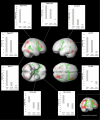Selective tuning of the blood oxygenation level-dependent response during simple target detection dissociates human frontoparietal subregions
- PMID: 17553994
- PMCID: PMC6672146
- DOI: 10.1523/JNEUROSCI.0851-07.2007
Selective tuning of the blood oxygenation level-dependent response during simple target detection dissociates human frontoparietal subregions
Abstract
Current models of working memory and focal attention converge on the idea of an adaptable global system, distributed across a network of frontal and parietal brain regions. Here, we examine how the human frontoparietal network selectively adapts to represent currently relevant information during a simple attentional task: monitoring for a target item in a series of nontargets. Across the entire frontoparietal network, there is selective response to targets, in line with a global system for coding task-relevant inputs. At the same time, there are striking dissociations in response to nontargets; whereas ventrolateral frontal cortex responds just to the target, more dorsal/anterior regions respond to all stimuli from the target category. The results show different degrees of target selectivity across different regions of the frontoparietal network.
Figures



References
-
- Bor D, Duncan J, Owen AM. The role of spatial configuration in tests of working memory explored with functional neuroimaging. Scand J Psychol. 2001;42:217–224. - PubMed
-
- Braver TS, Reynolds JR, Donaldson DI. Neural mechanisms of transient and sustained cognitive control during task switching. Neuron. 2003;39:713–726. - PubMed
-
- Brett M, Anton J, Valabregue R, Poline J. Region of interest analysis using an SPM toolbox. the Eighth International Conference on Functional Mapping of the Human Brain; June; Sendai, Japan. 2002. Paper presented at.
-
- Cusack R, Brett M, Osswald K. An evaluation of the use of magnetic field maps to undistort echo-planar images. NeuroImage. 2003;18:127–142. - PubMed
Publication types
MeSH terms
Substances
Grants and funding
LinkOut - more resources
Full Text Sources
Medical
